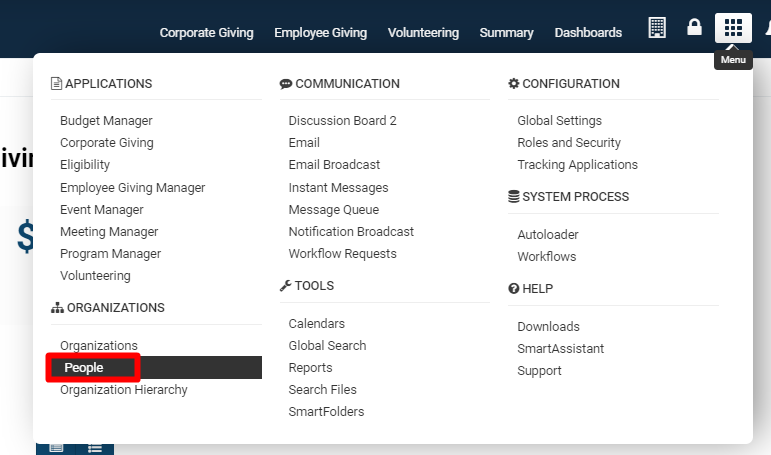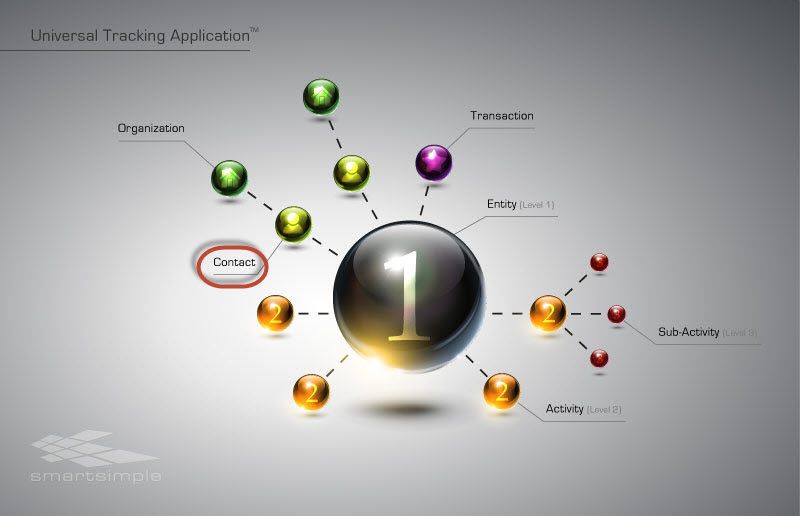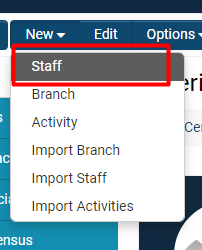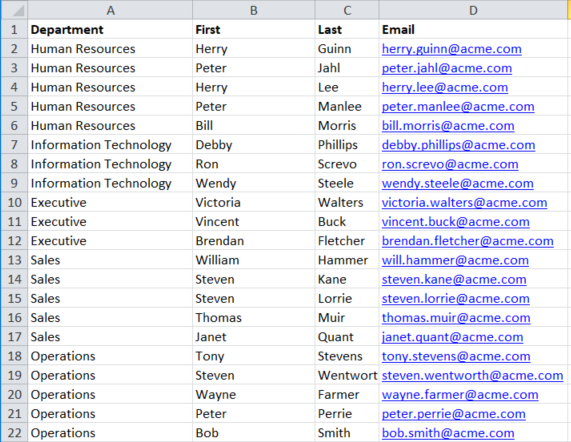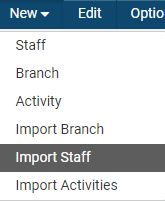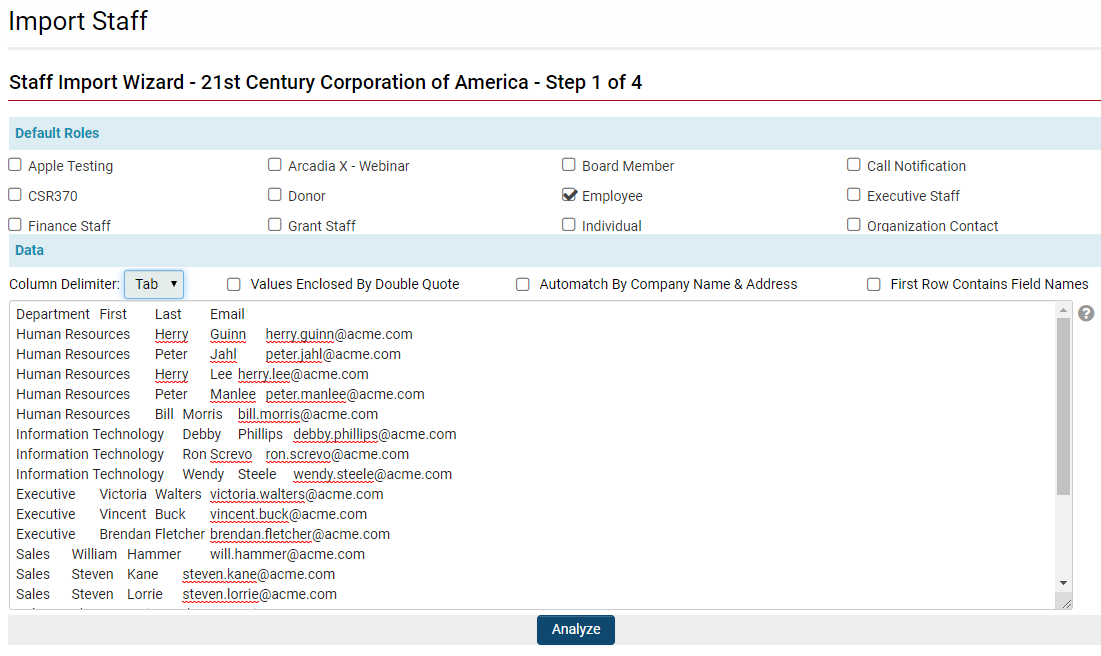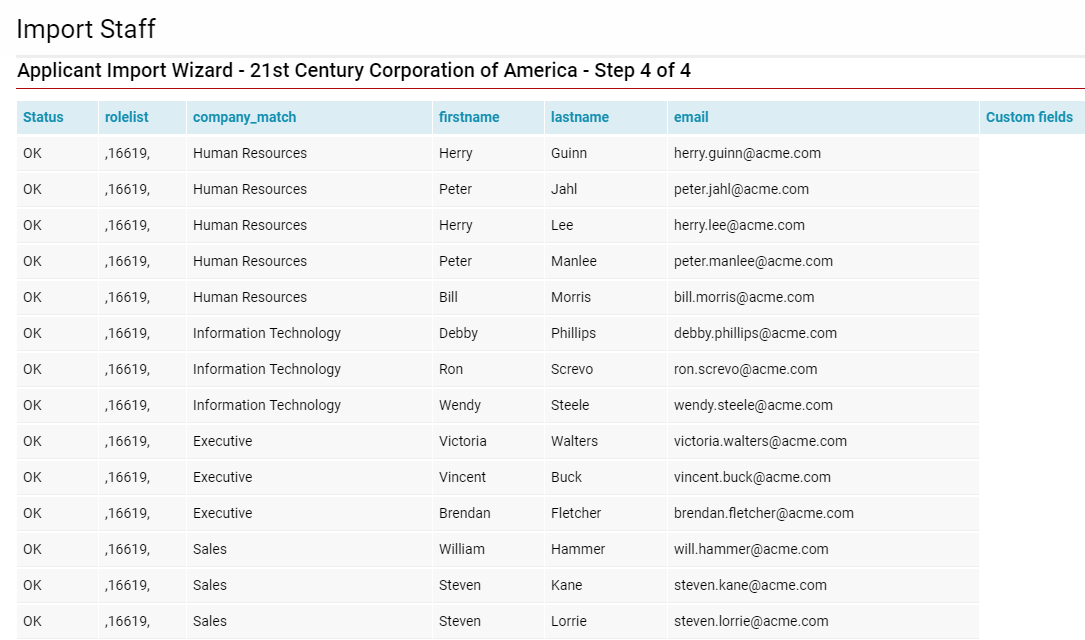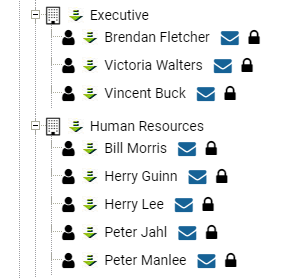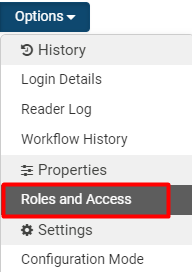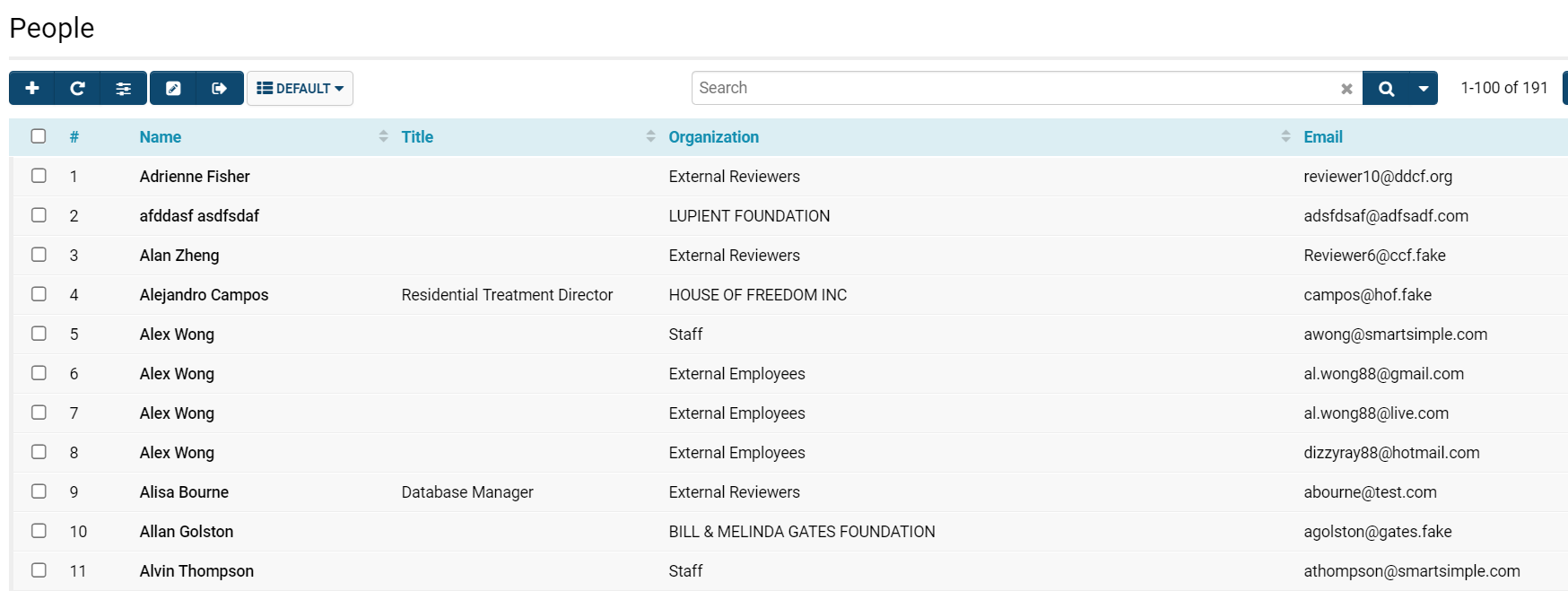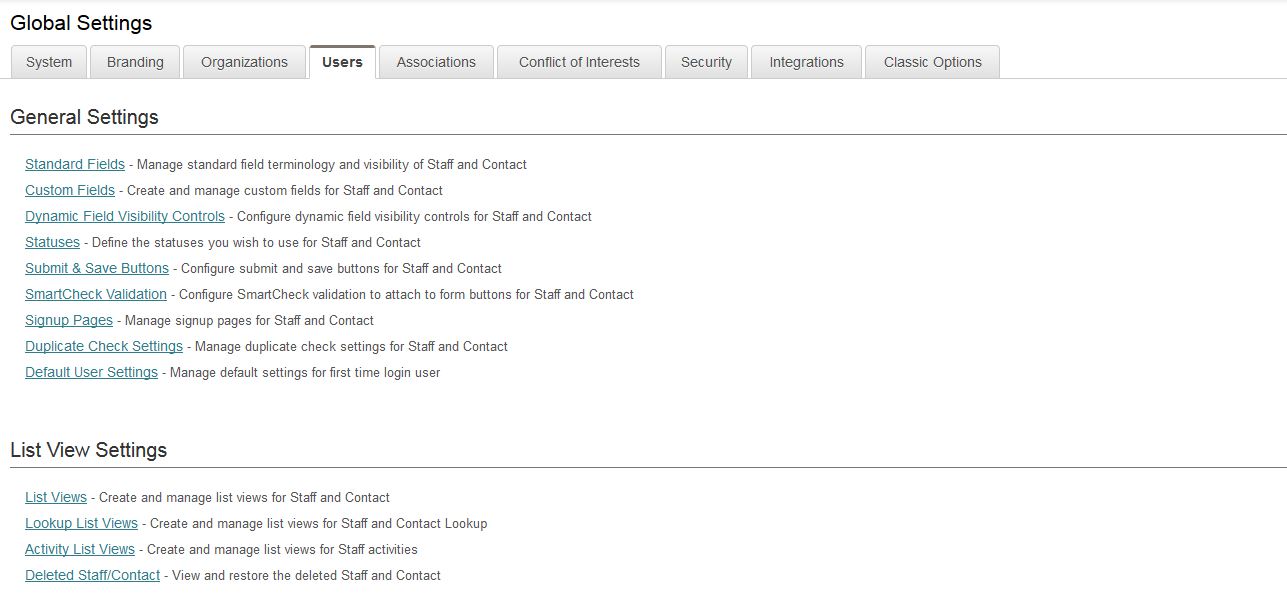Difference between revisions of "User"
| (64 intermediate revisions by 2 users not shown) | |||
| Line 7: | Line 7: | ||
* Because [[Organization Terminology]] will vary between instances, remember that your specific instance may use different nomenclature for users/contacts. The related functions such as how to activate or add users in every instance will remain the same. | * Because [[Organization Terminology]] will vary between instances, remember that your specific instance may use different nomenclature for users/contacts. The related functions such as how to activate or add users in every instance will remain the same. | ||
| + | * '''People '''added into the system are similar to [[Organization|organizations]] in their behaviour and functionality. A person object may store information about internal staff as well as external contacts/venders. All people are also stored in a single format and table in the database, each with their own set of [[User#Standard People Fields|standard fields]]. | ||
| + | * Each person will have a single parent organization in the [[Organization hierarchy]], though they represent a variety of users and contacts at the different organizational levels. For example, you might have '''Teaching Assistants '''and '''Professors '''at the '''Department '''level, and '''Deans '''at the '''University '''level. | ||
| − | As part of the contact setup process, you assign contacts "roles." A user can access and manipulate information only to the extent permitted through their membership of specific [[User Role|roles]], combined with those roles' [[Role Based Security ability]] to manage system-wide [[Manager Permission|permissions]]. Roles therefore define user access to system resources such as the [[interfaces|interface]] they see, the [[application]]s they can access, the [[fields]] they see within each application, and the [[reports]] they can run. | + | You can find ''all ''people in your SmartSimple instance by clicking on the 9-square menu icon on the top right of your page and clicking the '''People '''hyperlink. |
| + | |||
| + | ::: [[File:people access.png|500px|border]] | ||
| + | As part of the contact setup process, you assign contacts "roles." A user can access and manipulate information only to the extent permitted through their membership of specific [[User Role|roles]], combined with those roles' [[Role Based Security|ability]] to manage system-wide [[Manager Permission|permissions]]. Roles therefore define user access to system resources such as the [[interfaces|interface]] they see (Administrator vs normal user portal), the [[application]]s they can access, the [[fields]] they see within each application, and the [[reports]] they can run. | ||
* Example: A user who is a [[Global User Administrator|'''System Administrator''']] will have increased control and visibility to the system than a user whose role is simply '''Employee.''' | * Example: A user who is a [[Global User Administrator|'''System Administrator''']] will have increased control and visibility to the system than a user whose role is simply '''Employee.''' | ||
| Line 15: | Line 20: | ||
:: [[Image:Uta-diagram-800w-Contact.jpg|link=Getting Started with the Universal Tracking Application|600px|border]] | :: [[Image:Uta-diagram-800w-Contact.jpg|link=Getting Started with the Universal Tracking Application|600px|border]] | ||
| + | ==Configuration—Essentials== | ||
| + | Depending on your [[Role Based Security|role]], you may or may not be able to add, delete, and modify contacts. | ||
| + | Typically, the System Administrator role will have the highest amount of security access to all contacts. In some [[instance]]s, internal Staff roles may similarly be able to modify contacts. | ||
| − | == | + | All users are able to edit their own contact profile. |
| + | |||
| + | ===Adding Users and Contacts=== | ||
You can add people to the [[Organization hierarchy|organization hierarchy]] using any of the following techniques: | You can add people to the [[Organization hierarchy|organization hierarchy]] using any of the following techniques: | ||
| Line 23: | Line 33: | ||
* Uploading in bulk through [[Autoloader]] | * Uploading in bulk through [[Autoloader]] | ||
* Enabling one or more company [[Signup Page|sign up pages]] | * Enabling one or more company [[Signup Page|sign up pages]] | ||
| − | * Importing contacts from '''Microsoft Outlook''' using the [[SmartSimple Outlook Synchronization|Outlook Plug-in]] feature | + | * Importing contacts from '''Microsoft Outlook''' using the [[SmartSimple Outlook Synchronization|Outlook Plug-in]] feature [Deprecated download and support for Outlook Plug-in July 9, 2020] |
* Importing using the [[APIs|API]] functionality and a custom program that your organization could create | * Importing using the [[APIs|API]] functionality and a custom program that your organization could create | ||
| − | ===Manually Adding Users=== | + | ====Manually Adding Users==== |
'''Note: '''If you enable the login feature when adding people, they will be able to log into the system and you can consider them "users." Without this user activation, they are simply '''contacts.''' | '''Note: '''If you enable the login feature when adding people, they will be able to log into the system and you can consider them "users." Without this user activation, they are simply '''contacts.''' | ||
| Line 53: | Line 63: | ||
:: | :: | ||
::* Keep in mind that even if you select multiple roles, our system will default to the '''minimum''' level of access. | ::* Keep in mind that even if you select multiple roles, our system will default to the '''minimum''' level of access. | ||
| − | ::* If it is a brand new [[instance]], there may be no users in any role. In this situation, simply change the Role to '''No Role | + | ::* If it is a brand new [[instance]], there may be no users in any role. In this situation, simply change the Role to '''No Role Assigned '''by clicking '''Next.''' |
| + | |||
| + | 7. The new user details will appear, including [[Standard Fields|standard fields]] that should be filled out. | ||
| + | |||
| + | The fields marked by an asterisk ('''*''') are mandatory, meaning that without filling them in, you will not be able to proceed. | ||
| − | + | =====Standard People Fields===== | |
| + | The standard fields used to describe a person are as follows: | ||
| + | |||
| + | {| class="wikitable" | ||
| + | |- | ||
| + | ||'''Standard Field''' | ||
| + | ||'''Description''' | ||
| + | |- | ||
| + | ||First Name | ||
| + | ||The first name of the person | ||
| + | |- | ||
| + | ||Last Name | ||
| + | ||The last name of the person | ||
| + | |- | ||
| + | ||Title | ||
| + | ||Business title of the person | ||
| + | |- | ||
| + | ||Prefix/Suffix | ||
| + | ||Prefix and suffix of the contact | ||
| + | |- | ||
| + | ||Phone/Extension | ||
| + | ||Direct line for the person and their extension | ||
| + | |- | ||
| + | ||Email | ||
| + | ||Email address (an email address is required to allow a user to log into the system) | ||
| + | |- | ||
| + | ||Primary Contact | ||
| + | ||Check this box to indicate if this person is the primary contact at the organization | ||
| + | |- | ||
| + | ||Organization | ||
| + | ||The organization to which this person should be associated - changing the organization will move that person to another organization | ||
| + | |- | ||
| + | ||Address | ||
| + | ||If different from their organization, the street address of the person | ||
| + | |- | ||
| + | ||Address 2 | ||
| + | ||Additional address line (apartment or suite number, for example) | ||
| + | |- | ||
| + | ||City | ||
| + | ||If different from their organization, the city address of the person | ||
| + | |- | ||
| + | ||Province | ||
| + | ||If different from their organization, the province address of the person | ||
| + | |- | ||
| + | ||Country | ||
| + | ||If different from their organization, the country of the person | ||
| + | |- | ||
| + | ||Postal code | ||
| + | ||If different from their organization, the postal code of the person | ||
| + | |} | ||
| + | For more options about configuring a contact's standard fields, see [[Contact and Account Standard Fields]]. | ||
| + | |||
| + | 8. After filling in the user's standard fields, you may choose to '''Save Draft''' or '''Save''' the contact record. If you select '''Save Draft''', it will only store the information on the page. If you select '''Save''', it will validate the information on the page and the contact will be added. | ||
:::: [[File:ContactButtons.png|border]] | :::: [[File:ContactButtons.png|border]] | ||
| + | ====Importing Contacts==== | ||
| + | The import process consists of copying external information (ex: if it is already listed on an Excel file) onto an '''Import Window, '''validating the information mapping before uploading, and uploading the data to SmartSimple. If you need to split contact information, this technique will be repeated: once for [[Importing Organisation Records#Importing Organization Records|organization records]] that will categorize companies onto the [[Organization hierarchy|organization hierarchy]], and once for the contact data that will create profiles for users. | ||
| + | |||
| + | In the following step-by-step example, contact information from an Excel sheet will be imported onto a copy of SmartSimple. This process occurs after importing organization records, as the system will use the department names in this data to determine the correct level of association on the organization hierarchy for each user. | ||
| + | |||
| + | This example uses [[internal]] users, so they will need to be added to the internal hierarchy of the organization hierarchy. | ||
| + | |||
| + | :: [[File:excelimportinfo.png|420px|border]] | ||
| + | Before beginning this process, highlight rows A1 to D22 and select '''Ctrl + C '''to copy this information. | ||
| + | |||
| + | 1. Select the 9-square menu icon on the top right of your screen. | ||
| + | |||
| + | :: {{Icon-Menu}} | ||
| + | 2. Under the heading '''Organizations, '''select '''Organization Hierarchy. ''' | ||
| + | |||
| + | * The internal records are listed on the first tab. If you are uploading [[external]] contact information, simply complete this process on the second tab. | ||
| + | |||
| + | 3. Click the [[The Root Company|root organization]] name. | ||
| + | |||
| + | The root organization details are displayed. | ||
| + | |||
| + | 3. Click the '''New '''button, then select '''Import Staff. ''' | ||
| + | |||
| + | :: [[File:Import Staff Button.png|130px|border]] | ||
| + | : | ||
| + | :* Note that the term '''Staff '''may be different depending on your instance, as [[Organization Terminology|organization terminology]] is variable per SmartSimple instance. | ||
| + | |||
| + | '''Step 1 '''of the '''User Import Wizard '''is displayed. | ||
| + | |||
| + | 4. Paste the data into the '''Import Wizard.''' | ||
| + | |||
| + | 5. Set the [[User Role|role]] to '''Employee, '''or another relevant role that is available. | ||
| + | |||
| + | :* If a role you would like is unavailable, learn how to [[Creating User Roles|create user roles]]. | ||
| + | |||
| + | 6. Set the '''Column Delimiter '''to '''Tab.''' | ||
| + | |||
| + | ::: [[File:Import Staff.png|680px|border]] | ||
| + | 7. Check '''First Row Contains Field Names.''' | ||
| + | |||
| + | 8. Click the '''Analyze '''button. | ||
| + | |||
| + | 9. A pop-up will appear to confirm your action. Select the '''YES '''button. | ||
| + | |||
| + | :: [[File:Screenshot 14.png|250px|border]] | ||
| + | 10. The analyzed data of your imported records will appear. At this stage, you have the opportunity to '''deselect '''any employees you do not wish to add; you may also edit their information, such as their email addresses. At the bottom of the screen, you will see different methods to add users to the SmartSimple instance. Select one, then click '''Upload.''' | ||
| + | |||
| + | :: [[File:user activation.png|400px|border]] | ||
| + | : | ||
| + | :* The option to activate users and send them a password by email will explicitly notify your users that they have been added to your SmartSimple instance. This allows them to log in to the system and to manually change their password after. | ||
| + | |||
| + | 11. Your successfully imported contact records will appear in a list. | ||
| + | |||
| + | ::: [[File:SuccessfulImportStaff.png|650px|border]] | ||
| + | To ensure that your internal contact records have been imported, simply return to the '''Organization Hierarchy'''. By clicking the '''+''' button next to an internal organization, the associated contacts will appear. | ||
| + | |||
| + | ::: [[File: Org Hierarchy People Added.png|250px|border]] | ||
| + | You may also [[User#From the Organization Hierarchy|activate users]] from the '''Organization Hierarchy''' view if you did not previously activate them during the importing process. | ||
| + | |||
| + | =====[[Importing Organisation Records#Undoing an Upload|Undoing an Upload]]===== | ||
| + | If you have imported these contact records in error, you may [[Importing Organisation Records#Undoing an Upload|undo your upload]]. | ||
| + | |||
===Activating a User=== | ===Activating a User=== | ||
| + | ====From the Organization Hierarchy==== | ||
| + | Adding a user to a level of the hierarchy does not mean that when they log in they will be able to access the system. You must manually enable the user to have access to the system. This process will change a contact ''into'' a user from the '''Organization Hierarchy,''' therefore enabling them to specifically log in and access [[SmartSimple]]. | ||
| + | |||
| + | 1. Access the [[contact]](s) you are looking for with the 9-square [[menu]] icon on the top right of your screen. | ||
| + | |||
| + | :: {{Icon-Menu}} | ||
| + | 2. For a comprehensive list of all contacts, select '''People '''under the '''Organizations '''heading. | ||
| + | |||
| + | 3. From the [[Organization hierarchy,|Organization Hierarchy]] under '''Organizations, '''you may access contacts by finding them under their associated [[internal]] or [[external]] organization. | ||
| + | |||
| + | If the contact is inactive, they will have a lock icon next to their name.[[File:LockIcon.png|border]] | ||
| + | |||
| + | To the right of each [[User|user]] the following icons are displayed: [[File:EnvelopeIcon.png|border]][[File:KeyIcon.png|border]] | ||
| + | |||
| + | The '''Envelope''' icon will open the Message Center to send a message to the user. Another inter-user communication method is [[Using Instant Messaging|Instant Message]], although its function is more effectively used to see which users are currently online. | ||
| + | |||
| + | The '''Key''' icon indicates that this user can log into [[SmartSimple]] - their '''Status''' is set to '''Enabled''' in the '''User Settings'''. This status also means that they will receive emails or a new password if they select '''Forgot Password''' from their account. | ||
| + | |||
| + | 4. Click on the contact name to go to their [[Profile|profile]]. | ||
| + | |||
| + | 5. To activate the contact, select the grayed-out '''Key''' icon on the top right of their profile. | ||
| + | |||
| + | :: [[File:ActivateUser.png|border]] | ||
| + | 6. A confirmation pop-up will appear. You may choose to activate the user automatically (without password), active them and send an automated password to their email, or cancel the activation process. | ||
| + | |||
| + | [[File:ActivateUserConfirmation.png|350px]] | ||
| + | |||
| + | <pre> Activating users with this key icon can also be done from their specific user profile by locating the key icon on the top right of their page. </pre> | ||
====From Their Profile==== | ====From Their Profile==== | ||
| − | Adding a user to a level of the hierarchy does not mean that when they log in they will be able to access the system. You must manually enable the user to have access to the system. | + | Adding a user to a level of the hierarchy does not mean that when they log in they will be able to access the system. You must manually enable the user to have access to the system. This process will change a contact ''into ''a user from the '''Profile, '''therefore enabling them to specifically log in and access [[SmartSimple]]. |
| − | + | You can most efficiently activate a user from their profile using the same '''key icon '''from the [[Organization hierarchy|organization hierarchy]]. The key icon is located on the top right of the [[Profile|profile page]] of the user: | |
| − | + | :: [[File:Activate user icons.png|100px|border]] | |
| + | : | ||
| + | :* It will be ''greyed out ''if the user is not yet activated. | ||
| + | :* Clicking a greyed out key icon will activate the user. | ||
| + | :* Clicking a coloured key icon will '''deactivate '''the user. | ||
| + | The other option of activating a user from their '''Profile '''is to provide '''User Access: ''' | ||
| − | :: [[File:RolesandAccess.png|border]] | + | 1. On the [[Profile|profile page]] of the newly added user, select the '''Options''' button to reveal a drop-down menu. |
| + | |||
| + | 2. Under the heading '''Properties,''' select '''Roles and Access'''. | ||
| + | |||
| + | ::::: [[File:RolesandAccess.png|border]] | ||
3. Once the modal window of '''Roles and Access '''opens, look to the top left of the window to enable '''Advanced Options '''to open up Access Types. | 3. Once the modal window of '''Roles and Access '''opens, look to the top left of the window to enable '''Advanced Options '''to open up Access Types. | ||
| − | 4. To enable typical '''User Access, '''toggle on '''User Access. '''If you would like to make a new user a [[Global User Administrator|'''System Administrator''']], then toggle that option on the right. | + | {| class="wikitable" |
| + | |- | ||
| + | ||'''Access Type''' | ||
| + | ||'''Functionality''' | ||
| + | |- | ||
| + | ||User Access | ||
| + | ||Provides access to the system to the extent permitted through the user's membership of specific [[roles]] | ||
| + | |- | ||
| + | ||API Access | ||
| + | ||An account type used to access data in a SmartSimple instance via an [[API]] (Application Programming Interface) - does not give access to SmartSimple interface directly | ||
| + | |- | ||
| + | || | ||
| + | =====No Access===== | ||
| + | || | ||
| + | The user will not be able to log into the system | ||
| + | |||
| + | :* Toggling on this option will disable user access to your SmartSimple copy | ||
| + | :* '''If the user is currently logged in they will not lose access until they try to log in again'''. | ||
| + | |||
| + | |- | ||
| + | || | ||
| + | =====Global Administrator===== | ||
| + | (System Administrator) | ||
| + | |||
| + | || | ||
| + | The user will be able to control the entire [[Organization Hierarchy|organization hierarchy]] within your SmartSimple copy. They will be able to: | ||
| + | |||
| + | :* Create additional users at any level - including additional [[Global User Administrator|System Administrators]] | ||
| + | :* Create new sub-organizations, both [[internal]] and [[external]] | ||
| + | :* Subscribe organizations to SmartSimple application programs, such as [[SmartFolders]] | ||
| + | :* Upload organization and contact information, both [[internal]] and [[external]] | ||
| + | :* Create [[roles]] and collaborative [[Workflows]] | ||
| + | For more information, and to find out how to enable or disable the '''SysAdmin '''role for users, see [[Global User Administrator]]. | ||
| + | |||
| + | |} | ||
| + | <br data-attributes="%20/">4. To enable typical '''User Access, '''toggle on '''User Access. '''If you would like to make a new user a [[Global User Administrator|'''System Administrator''']], then toggle that option on the right. | ||
| + | |||
| + | ::::: [[File:EditRolesandAccess.png|500px|border]] | ||
| + | <u>'''Setting Login Restrictions'''</u> | ||
| − | : | + | :* [Deprecated March 11, 2021] You are able to restrict a user's access to SmartSimple to a specific workstation by setting the IP address of the workstation in their profile. Alternatively, you may '''lock '''the user to the next workstation that they use to log into the system by toggling the '''Workstation - lock. ''' |
| + | :* If you only wish for a user to have access to the system for a specific time period, you can toggle the '''Will Expire '''option and set the expiry date, after which the user will no longer be able to access the system. | ||
5. After saving the access options that you have selected, the buttons at the bottom of the modal window will display password setting and sending options. | 5. After saving the access options that you have selected, the buttons at the bottom of the modal window will display password setting and sending options. | ||
| + | :*::: [[File:Password.png|border]] | ||
| + | :*:: | ||
| + | :*::* If you select '''Send Password, '''the user will receive an automated password in an email. From there, they can log into the SmartSimple system and change their password manually. | ||
| + | :*::* The option to '''Set Password '''is not typically recommended except in necessary situations, such as if a client on the phone demands for a timely setting of the password. The '''Set Password '''option is also highly recommended when you are testing on the [[Backup Server and Testing Instance]], as an email will not be triggered and sent to the user regardless.. | ||
| + | :*::* You may also '''Reset '''a user's password using this '''Set Password '''option. | ||
| − | |||
| − | |||
| − | |||
| − | |||
After following these steps, your new user is now enabled to log into the system with their password. | After following these steps, your new user is now enabled to log into the system with their password. | ||
| − | === | + | For more comprehensive information regarding SmartSimple user passwords, see our [[Password Policy]]. |
| − | This | + | |
| + | ===Searching for Users=== | ||
| + | An easy way to access all of your instance's people records is directly through the '''People '''page. | ||
| + | |||
| + | 1. Click the 9-square menu icon on the top right of your page. | ||
| + | |||
| + | ::: {{Icon-Menu}} | ||
| + | 2. Under the heading '''Organizations, '''select '''People.''' | ||
| + | |||
| + | The '''People '''page is displayed. | ||
| + | |||
| + | ::: [[File:PeopleList.png|700px|border]] | ||
| + | All contacts will be listed, both [[internal]] and [[external]]. If there are security rules in place, such as '''view own accounts only''' under [[Roles and Security Settings]], you might not be able to see all contacts. | ||
| + | |||
| + | The page is divided into a number of areas: | ||
| + | |||
| + | :* '''People List''': This area will display people based on the selection criteria. Initially all contacts are displayed. The columns displayed for this list can be configured based on [[List View Overview|List Views]]. | ||
| + | :* '''Search''': You can set the criteria for searching specific people, based on [[Basic Search]] or [[Advanced Search]] functionality. | ||
| + | |||
| + | ==Configuration—Advanced== | ||
| + | ===Restore or Purge Deleted Contacts=== | ||
| + | <pre> NOTE: Any records that have been deleted for over one year will be automatically purged. </pre> | ||
| + | When a user deletes a company or contact, they are not actually deleted from the system database until a year has passed, although they will be marked as deleted and will not appear in any future interactions. | ||
| + | |||
| + | If the company or contact is deleted by accident, then a System Administrator can restore them by taking the following steps: | ||
| + | |||
| + | 1. Click the 9-square menu icon on the top right of your page. | ||
| + | |||
| + | {{Icon-Menu}} | ||
| − | + | 2. Under the heading '''Configuration,''' select '''Global Settings.''' | |
| + | For deleted '''Company''' records, under the '''Organizations''' tab, select '''Deleted Companies & Accounts.''' | ||
| − | + | For deleted '''Contact''' records, under the '''Users''' tab, select '''Deleted Staff & Contacts.''' | |
| + | 3. Click on the records that you want to be restored. | ||
| − | + | '''Contacts''': | |
| − | + | ::: [[File:PurgeContact2017.png|800px|border]] | |
| − | + | '''Companies''': | |
| − | : | + | ::: [[File:PurgeOrg2017.png|800px|border]] |
| + | 4. Click the '''Restore '''button. | ||
| − | The | + | The records are restored, along with any of their associated activities, notes, and [[Custom Fields|custom fields]]. Note that when a deleted company is restored, all associated deleted contacts will also be restored. |
| − | + | If you select certain records and click the '''Purge '''button, the records will be permanently purged - you will not be able to restore them under any circumstances. | |
| − | + | For restoring deleted records (such as activities associated with [[Universal Tracking Application]]s), a similar process is followed. Find out how to restore those [[Restoring Deleted Records|here]]. | |
| − | + | ===User & Contact Settings=== | |
| + | Note that the terms '''Staff '''and '''Contact '''may have been [[Organization Terminology|renamed]] in your instance of SmartSimple. | ||
| + | To modify the settings associated with users: | ||
| + | 1. Click on the 9-square menu icon on the top right of your page. | ||
| − | + | ::: {{Icon-Menu}} | |
| + | 2. Under the heading '''Configuration, '''select '''Global Settings '''(available to {{GUA}} only). | ||
| − | + | 3. Under the tab '''Users, '''you will see the following hyperlinked setting categories: | |
| − | [[File: | + | ::: [[File:StaffAndContactSettings2017.png|link=|900px|border]] |
| + | :: | ||
| + | ::* '''Standard Fields: '''[[Contact and Account Standard Fields|Standard fields]] associated with users. | ||
| + | ::* '''Custom Fields: '''[[Custom Fields|Custom fields]] associated with both [[internal]] and [[external]] users. | ||
| + | ::* '''Dynamic Field Visibility Controls: '''Configure dynamic field visibility controls for users. | ||
| + | ::* '''Statuses: '''Statuses used for users. | ||
| + | ::* '''Submit & Save Buttons: '''Submit & Save buttons used for users. | ||
| + | ::* '''SmartCheck Validation:''' SmartCheck validation to attach to form buttons for users. | ||
| + | ::* '''Signup Pages: '''Used to manage [[Creating a Signup Page|external web pages where contacts can register]]. | ||
| + | ::* '''Duplicate Check Setting: '''Allows you to define which fields are prompted for and compared with existing Contacts for duplicates when adding new users. See [[Duplicate Check]]. | ||
| + | ::* '''Default User Settings: '''Manage default settings for first time login user. | ||
| + | ::* '''List Views: '''Used to configure the [[List View|list view]] for users. | ||
| + | ::* '''Lookup List Views: '''Used to configure the fields shown when using an [[Ajax]] lookup on users; also determines the [[List View|list view]] for the Lookup dialog for the [[standard field]] "Organization" in the {{UTA}}. See [[Configuring Ajax Lists Views]]. | ||
| + | ::* '''Activity List Views: '''Used to configure the [[List View]] for the activities of users. | ||
| + | ::* '''Deleted Staff/Contact: '''Allows you to view, restore, or purge recently deleted users. For more complete instructions, see [[User#Restore or Purge Deleted Contacts|here]]. | ||
==See Also== | ==See Also== | ||
| − | :* [[Administrator]] | + | ::* [[Administrator]] |
| − | :* {{GUA}} | + | ::* {{GUA}} |
| − | :* | + | ::* [[Profile]] |
| − | :* [[ | + | ::* [[Reporting on User Type and Access Type]] |
| + | ::* [[Password Policy]] | ||
| + | ::* [[Maintaining Users - video]] | ||
| + | ::* [[Relating Contacts and Accounts to the Universal Tracking Application]] | ||
| + | ::* [[Signup Page]] | ||
| + | ::* [[Association Settings]] | ||
[[Category:Glossary]][[Category:Contacts]] | [[Category:Glossary]][[Category:Contacts]] | ||
Latest revision as of 08:56, 8 December 2021
Overview
A user is a contact that can log in and access a SmartSimple instance. If you use the enable login feature when adding contacts, they will be able to log into the system and you can consider them "users"; otherwise, you can consider them simply as "contacts." When enabling login access for contacts, you can choose to send each person an email containing their username, password, and the URL to access your instance of SmartSimple.
- Because Organization Terminology will vary between instances, remember that your specific instance may use different nomenclature for users/contacts. The related functions such as how to activate or add users in every instance will remain the same.
- People added into the system are similar to organizations in their behaviour and functionality. A person object may store information about internal staff as well as external contacts/venders. All people are also stored in a single format and table in the database, each with their own set of standard fields.
- Each person will have a single parent organization in the Organization hierarchy, though they represent a variety of users and contacts at the different organizational levels. For example, you might have Teaching Assistants and Professors at the Department level, and Deans at the University level.
You can find all people in your SmartSimple instance by clicking on the 9-square menu icon on the top right of your page and clicking the People hyperlink.
As part of the contact setup process, you assign contacts "roles." A user can access and manipulate information only to the extent permitted through their membership of specific roles, combined with those roles' ability to manage system-wide permissions. Roles therefore define user access to system resources such as the interface they see (Administrator vs normal user portal), the applications they can access, the fields they see within each application, and the reports they can run.
- Example: A user who is a System Administrator will have increased control and visibility to the system than a user whose role is simply Employee.
- Note: Although a user can be attributed with multiple roles, the system will always default to the minimum level of access.
Configuration—Essentials
Depending on your role, you may or may not be able to add, delete, and modify contacts. Typically, the System Administrator role will have the highest amount of security access to all contacts. In some instances, internal Staff roles may similarly be able to modify contacts.
All users are able to edit their own contact profile.
Adding Users and Contacts
You can add people to the organization hierarchy using any of the following techniques:
- Manually entering contacts
- Uploading in bulk through Import Wizards
- Uploading in bulk through Autoloader
- Enabling one or more company sign up pages
- Importing contacts from Microsoft Outlook using the Outlook Plug-in feature [Deprecated download and support for Outlook Plug-in July 9, 2020]
- Importing using the API functionality and a custom program that your organization could create
Manually Adding Users
Note: If you enable the login feature when adding people, they will be able to log into the system and you can consider them "users." Without this user activation, they are simply contacts.
People are always added to some level of the hierarchy; so, when you wish to add a new person, you must first select the appropriate organization level.
1. Click the 9-square menu icon on the top right of your screen.
2. Under the heading Organizations, select Organization Hierarchy.
3. Select the organization to which you wish to add the new person.
- The root organization is listed first underneath both the internal and external tabs.
- The internal records are listed underneath the first tab; the external records are listed underneath the second.
- Depending on the instance, the terminology of your internal vs external headings will vary.
4. Click the New button, which will reveal drop-down that allows you add a new user.
-
- Our duplication check relies on email information, so if a user has the same email as someone who is already in the system, they will not be added as a new contact.
6. If Roles are available to your SmartSimple instance, you may have to select which role you want this contact to fit into.
-
- Keep in mind that even if you select multiple roles, our system will default to the minimum level of access.
- If it is a brand new instance, there may be no users in any role. In this situation, simply change the Role to No Role Assigned by clicking Next.
7. The new user details will appear, including standard fields that should be filled out.
The fields marked by an asterisk (*) are mandatory, meaning that without filling them in, you will not be able to proceed.
Standard People Fields
The standard fields used to describe a person are as follows:
| Standard Field | Description |
| First Name | The first name of the person |
| Last Name | The last name of the person |
| Title | Business title of the person |
| Prefix/Suffix | Prefix and suffix of the contact |
| Phone/Extension | Direct line for the person and their extension |
| Email address (an email address is required to allow a user to log into the system) | |
| Primary Contact | Check this box to indicate if this person is the primary contact at the organization |
| Organization | The organization to which this person should be associated - changing the organization will move that person to another organization |
| Address | If different from their organization, the street address of the person |
| Address 2 | Additional address line (apartment or suite number, for example) |
| City | If different from their organization, the city address of the person |
| Province | If different from their organization, the province address of the person |
| Country | If different from their organization, the country of the person |
| Postal code | If different from their organization, the postal code of the person |
For more options about configuring a contact's standard fields, see Contact and Account Standard Fields.
8. After filling in the user's standard fields, you may choose to Save Draft or Save the contact record. If you select Save Draft, it will only store the information on the page. If you select Save, it will validate the information on the page and the contact will be added.
Importing Contacts
The import process consists of copying external information (ex: if it is already listed on an Excel file) onto an Import Window, validating the information mapping before uploading, and uploading the data to SmartSimple. If you need to split contact information, this technique will be repeated: once for organization records that will categorize companies onto the organization hierarchy, and once for the contact data that will create profiles for users.
In the following step-by-step example, contact information from an Excel sheet will be imported onto a copy of SmartSimple. This process occurs after importing organization records, as the system will use the department names in this data to determine the correct level of association on the organization hierarchy for each user.
This example uses internal users, so they will need to be added to the internal hierarchy of the organization hierarchy.
Before beginning this process, highlight rows A1 to D22 and select Ctrl + C to copy this information.
1. Select the 9-square menu icon on the top right of your screen.
2. Under the heading Organizations, select Organization Hierarchy.
- The internal records are listed on the first tab. If you are uploading external contact information, simply complete this process on the second tab.
3. Click the root organization name.
The root organization details are displayed.
3. Click the New button, then select Import Staff.
-
- Note that the term Staff may be different depending on your instance, as organization terminology is variable per SmartSimple instance.
Step 1 of the User Import Wizard is displayed.
4. Paste the data into the Import Wizard.
5. Set the role to Employee, or another relevant role that is available.
- If a role you would like is unavailable, learn how to create user roles.
6. Set the Column Delimiter to Tab.
7. Check First Row Contains Field Names.
8. Click the Analyze button.
9. A pop-up will appear to confirm your action. Select the YES button.
10. The analyzed data of your imported records will appear. At this stage, you have the opportunity to deselect any employees you do not wish to add; you may also edit their information, such as their email addresses. At the bottom of the screen, you will see different methods to add users to the SmartSimple instance. Select one, then click Upload.
-
- The option to activate users and send them a password by email will explicitly notify your users that they have been added to your SmartSimple instance. This allows them to log in to the system and to manually change their password after.
11. Your successfully imported contact records will appear in a list.
To ensure that your internal contact records have been imported, simply return to the Organization Hierarchy. By clicking the + button next to an internal organization, the associated contacts will appear.
You may also activate users from the Organization Hierarchy view if you did not previously activate them during the importing process.
Undoing an Upload
If you have imported these contact records in error, you may undo your upload.
Activating a User
From the Organization Hierarchy
Adding a user to a level of the hierarchy does not mean that when they log in they will be able to access the system. You must manually enable the user to have access to the system. This process will change a contact into a user from the Organization Hierarchy, therefore enabling them to specifically log in and access SmartSimple.
1. Access the contact(s) you are looking for with the 9-square menu icon on the top right of your screen.
2. For a comprehensive list of all contacts, select People under the Organizations heading.
3. From the Organization Hierarchy under Organizations, you may access contacts by finding them under their associated internal or external organization.
If the contact is inactive, they will have a lock icon next to their name.![]()
To the right of each user the following icons are displayed: ![]()
![]()
The Envelope icon will open the Message Center to send a message to the user. Another inter-user communication method is Instant Message, although its function is more effectively used to see which users are currently online.
The Key icon indicates that this user can log into SmartSimple - their Status is set to Enabled in the User Settings. This status also means that they will receive emails or a new password if they select Forgot Password from their account.
4. Click on the contact name to go to their profile.
5. To activate the contact, select the grayed-out Key icon on the top right of their profile.
6. A confirmation pop-up will appear. You may choose to activate the user automatically (without password), active them and send an automated password to their email, or cancel the activation process.
Activating users with this key icon can also be done from their specific user profile by locating the key icon on the top right of their page.
From Their Profile
Adding a user to a level of the hierarchy does not mean that when they log in they will be able to access the system. You must manually enable the user to have access to the system. This process will change a contact into a user from the Profile, therefore enabling them to specifically log in and access SmartSimple.
You can most efficiently activate a user from their profile using the same key icon from the organization hierarchy. The key icon is located on the top right of the profile page of the user:
-
- It will be greyed out if the user is not yet activated.
- Clicking a greyed out key icon will activate the user.
- Clicking a coloured key icon will deactivate the user.
The other option of activating a user from their Profile is to provide User Access:
1. On the profile page of the newly added user, select the Options button to reveal a drop-down menu.
2. Under the heading Properties, select Roles and Access.
3. Once the modal window of Roles and Access opens, look to the top left of the window to enable Advanced Options to open up Access Types.
| Access Type | Functionality |
| User Access | Provides access to the system to the extent permitted through the user's membership of specific roles |
| API Access | An account type used to access data in a SmartSimple instance via an API (Application Programming Interface) - does not give access to SmartSimple interface directly |
No Access |
The user will not be able to log into the system
|
Global Administrator(System Administrator) |
The user will be able to control the entire organization hierarchy within your SmartSimple copy. They will be able to:
For more information, and to find out how to enable or disable the SysAdmin role for users, see Global User Administrator. |
4. To enable typical User Access, toggle on User Access. If you would like to make a new user a System Administrator, then toggle that option on the right.
Setting Login Restrictions
- [Deprecated March 11, 2021] You are able to restrict a user's access to SmartSimple to a specific workstation by setting the IP address of the workstation in their profile. Alternatively, you may lock the user to the next workstation that they use to log into the system by toggling the Workstation - lock.
- If you only wish for a user to have access to the system for a specific time period, you can toggle the Will Expire option and set the expiry date, after which the user will no longer be able to access the system.
5. After saving the access options that you have selected, the buttons at the bottom of the modal window will display password setting and sending options.
-
- If you select Send Password, the user will receive an automated password in an email. From there, they can log into the SmartSimple system and change their password manually.
- The option to Set Password is not typically recommended except in necessary situations, such as if a client on the phone demands for a timely setting of the password. The Set Password option is also highly recommended when you are testing on the Backup Server and Testing Instance, as an email will not be triggered and sent to the user regardless..
- You may also Reset a user's password using this Set Password option.
After following these steps, your new user is now enabled to log into the system with their password.
For more comprehensive information regarding SmartSimple user passwords, see our Password Policy.
Searching for Users
An easy way to access all of your instance's people records is directly through the People page.
1. Click the 9-square menu icon on the top right of your page.
2. Under the heading Organizations, select People.
The People page is displayed.
All contacts will be listed, both internal and external. If there are security rules in place, such as view own accounts only under Roles and Security Settings, you might not be able to see all contacts.
The page is divided into a number of areas:
- People List: This area will display people based on the selection criteria. Initially all contacts are displayed. The columns displayed for this list can be configured based on List Views.
- Search: You can set the criteria for searching specific people, based on Basic Search or Advanced Search functionality.
Configuration—Advanced
Restore or Purge Deleted Contacts
NOTE: Any records that have been deleted for over one year will be automatically purged.
When a user deletes a company or contact, they are not actually deleted from the system database until a year has passed, although they will be marked as deleted and will not appear in any future interactions.
If the company or contact is deleted by accident, then a System Administrator can restore them by taking the following steps:
1. Click the 9-square menu icon on the top right of your page.
2. Under the heading Configuration, select Global Settings.
For deleted Company records, under the Organizations tab, select Deleted Companies & Accounts.
For deleted Contact records, under the Users tab, select Deleted Staff & Contacts.
3. Click on the records that you want to be restored.
Contacts:
Companies:
4. Click the Restore button.
The records are restored, along with any of their associated activities, notes, and custom fields. Note that when a deleted company is restored, all associated deleted contacts will also be restored.
If you select certain records and click the Purge button, the records will be permanently purged - you will not be able to restore them under any circumstances.
For restoring deleted records (such as activities associated with Universal Tracking Applications), a similar process is followed. Find out how to restore those here.
User & Contact Settings
Note that the terms Staff and Contact may have been renamed in your instance of SmartSimple. To modify the settings associated with users:
1. Click on the 9-square menu icon on the top right of your page.
2. Under the heading Configuration, select Global Settings (available to Global User Administrator only).
3. Under the tab Users, you will see the following hyperlinked setting categories:
-
- Standard Fields: Standard fields associated with users.
- Custom Fields: Custom fields associated with both internal and external users.
- Dynamic Field Visibility Controls: Configure dynamic field visibility controls for users.
- Statuses: Statuses used for users.
- Submit & Save Buttons: Submit & Save buttons used for users.
- SmartCheck Validation: SmartCheck validation to attach to form buttons for users.
- Signup Pages: Used to manage external web pages where contacts can register.
- Duplicate Check Setting: Allows you to define which fields are prompted for and compared with existing Contacts for duplicates when adding new users. See Duplicate Check.
- Default User Settings: Manage default settings for first time login user.
- List Views: Used to configure the list view for users.
- Lookup List Views: Used to configure the fields shown when using an Ajax lookup on users; also determines the list view for the Lookup dialog for the standard field "Organization" in the . See Configuring Ajax Lists Views.
- Activity List Views: Used to configure the List View for the activities of users.
- Deleted Staff/Contact: Allows you to view, restore, or purge recently deleted users. For more complete instructions, see here.
